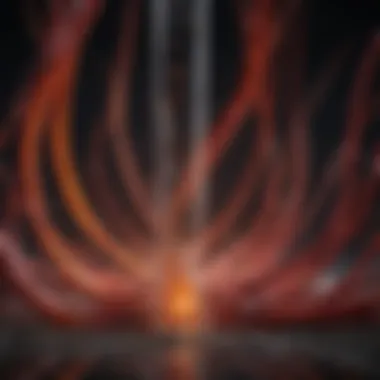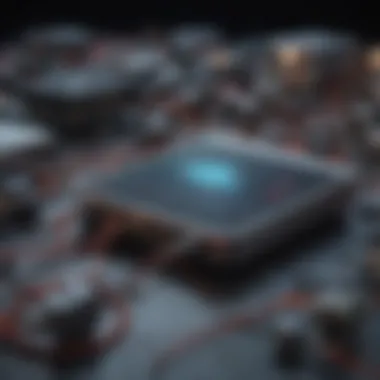Understanding Vampire Energy: A Deep Dive


Research Overview
Prelude to the Topic Under Study
Vampire energy, sometimes referred to as phantom load or ghost load, is an often neglected yet pertinent issue in our daily lives. Essentially, this concept deals with the energy that electronic devices consume when they are not actively in use but still plugged into an outlet. This silent energy drain poses a notable challenge both environmentally and economically. Beyond devices, the notion extends to interpersonal relationships, where emotional or psychological drain can feel just as consuming, leading to what we might casually refer to as ‘energy vampires.’ Understanding the duality of this term can empower individuals to recognize and mitigate its impacts.
Summary of Existing Research Findings
Different studies, including those presented in reputable journals, show a concerning trend regarding household energy consumptionlinked to vampire energy. Electric devices, such as televisions, chargers, and even printers, can keep sipping power despite being turned off but still plugged in. Some estimations suggest that vampire energy can account for up to 10% of a home's total energy use. In terms of our social interactions, research indicates that engaging with certain individuals can subtly drain our emotional energy, suggesting that both realms deserve critical examination.
Key Research Methodology Explained
Researchers adopt a range of methodologies to elucidate the implications of vampire energy. Surveys and energy audits are commonly used to track energy consumption patterns in households, while psychological profiling offers insights into social dynamics. By utilizing a mix of qualitative and quantitative approaches, findings are woven together, presenting a clearer picture of both technological and interpersonal energy drains.
Health Implications
Discussion on the Impact of the Research on Health
The repercussions of vampire energy can manifest in various forms. Environmentally, an increase in energy consumption leads to higher carbon footprints, impacting public health indirectly through pollution. On an individual level, continuous exposure to energy-draining relationships can lead to fatigue, stress, and a general sense of being overwhelmed.
Exploration of Potential Benefits and Risks
Recognizing and addressing vampire energy can provide tangible benefits. Reducing energy wastage not only lowers utility bills but also contributes to more sustainable living. Conversely, the idea of cutting ties or distancing oneself from emotionally draining individuals carries potential risks, such as feelings of loneliness or guilt.
Examples of How the Findings Can Be Applied in Daily Life
A practical way to tackle these issues can be as simple as unplugging devices after use or utilizing smart power strips that automatically cut power. Likewise, setting boundaries with friends and family can create healthier emotional dynamics, aiding in personal well-being.
Well-being Strategies
Practical Tips and Strategies Derived from the Research
Engaging with both aspects of vampire energy, here are a few routes to optimization:
- Reduce energy consumption: Unplug devices when not in use, invest in energy-efficient appliances, and consider upgrade options.
- Emotional boundaries: Recognize who in your social circle tends to drain your vitality. Setting limits can encourage a healthier give-and-take in relationships.
Advice on Implementing Positive Changes for Well-being
Start by conducting a thorough energy audit of your home. This self-assessment helps identify which devices are guzzling energy. For interpersonal improvements, initiate open conversations with those you feel drained by – often, communication can ease the burden.
Personal Stories or Case Studies Supporting the Strategies
For example, a family who decided to unplug their appliances reported a noticeable decrease in their monthly bills. On a social level, an individual found that by politely turning down invitations to events that drained her, she regained a sense of peace and revitalized her energy.
Expert Insights
Analysis of Expert Opinions on the Research Findings
Experts in energy conservation argue that awareness is the first step towards combating vampire energy. The consensus is clear: simple changes in our routines can lead to significant reductions in wasted energy, both in devices and relationships.
Q&A Session with a Relevant Expert on the Topic
Q: How significant is vampire energy in terms of overall energy consumption?
A: Studies show it can make up a significant portion, often going unnoticed until households take a closer look at their energy bills.
Foreword to Vampire Energy
The concept of vampire energy is often brushed off as a minor detail in the broader subject of energy consumption. Yet, it holds significant importance in today’s fast-paced world. The average household harbors a cornucopia of devices, each with their own consumption habits, which may imperil both our wallets and the environment. Understanding vampire energy enlightens us about how and why devices, even when they seem inactive, continue to draw power. This awareness is not just an enlightening tidbit; it can lead to tangible benefits in energy conservation and cost savings.
By exploring the nuances of this phenomenon, we can take charge of our energy use and foster a more sustainable lifestyle. Reducing energy waste translates not only to lower bills but also to a smaller carbon footprint – a win-win for both our pockets and the planet.
Definition of Vampire Energy
Vampire energy refers to the energy consumed by electronics when they are in standby mode or simply plugged in, yet not actively being used. This phenomenon is more commonly recognized as "phantom load."
The term itself evokes a vivid image, likening these devices to vampires that silently drain power while we remain blissfully unaware. Ranging from washing machines to mobile phone chargers, many household items participate in this unseen energy drain. According to estimates, these phantom loads can account for 5% to 10% of an average home’s energy usage, showcasing just how pervasive this issue is.
To illustrate, a common example might be a television left plugged in after watching your favorite show, drawing power for a remote that isn’t in use until the next binge-watch session. This sort of energy loss accumulates over time, significantly impacting both energy bills and environmental sustainability.
Historical Context
The roots of vampire energy can be traced back to the dawn of electrical appliances. As technology advanced, manufacturers incorporated convenience features like timers and remote controls into everyday devices, inadvertently setting the stage for vampire energy. On one hand, these innovations made life simpler by allowing users to enjoy convenience; on the other, they paved a way for energy waste.
Historically, incandescent bulbs and analog devices contributed minimally to phantom load issues. It wasn't until the widespread adoption of digital devices and smart technology that vampire energy burgeoned into a noteworthy problem.
Government regulations and energy efficiency movements have sought to address this growing concern. For instance, initiatives were launched to educate consumers on the hidden costs associated with standby power consumption. Yet, many users remain unaware of the actual energy drain taking place within their homes.
As we move forward into a future reliant on technology and connectivity, recognizing vampire energy and its implications will be crucial for achieving energy efficiency goals.
Key Points to Consider
- Vampire energy is the energy consumed when devices are not in use but still plugged in.
- It can significantly contribute to a household's overall energy consumption.
- Awareness and understanding of this phenomenon can lead to practical steps for energy conservation.
- Technological advancements have both contributed to and mitigated vampire energy's prevalence.
This introduction fosters a foundation for a deeper examination of vampire energy, delving into its types, impacts, and potential solutions.
Types of Vampire Energy
Understanding the various forms of vampire energy is critical, as each type represents different challenges and solutions to energy waste in our lives. By identifying these varieties, we can take concrete steps towards managing them effectively. The significance of the discussion lies in recognizing how both electronic and emotional aspects of vampire energy affect our daily lives. Gaining insight into these types can empower individuals to make more informed decisions in both their technological use and interpersonal interactions.
Electric Vampire Energy


Electric vampire energy primarily pertains to the unnecessary energy consumption by electronic devices that remain plugged yet inactive. This not only has environmental ramifications but economic consequences as well, which we will explore further.
Standby Power Consumption
Standby power consumption, often called "phantom power," refers to the energy used by devices when they are switched off but still plugged in. This can include televisions, gaming consoles, and even chargers left connected to the wall. One standout characteristic of standby power is its incredible subtlety; there are instances when individuals might not realize these devices are consuming energy when not in active use.
This consumption, while seemingly small on a per-device basis, accumulates to considerable costs over time. For instance, a television on standby can draw between 1 to 10 watts continuously, adding up to substantial energy costs annually. A beneficial takeaway from discussing standby power is the potential for widespread savings and reduced energy demand by encouraging habit changes, such as unplugging devices or using energy-saving modes when possible.
Additionally, a unique feature of standby power consumption is its ease of mitigation. With the introduction of smart power strips, users can easily prevent devices from drawing unnecessary power. Nevertheless, the downside is that excessive reliance on these solutions might lead to complacency regarding more proactive energy-saving efforts.
Phantom Loads
Phantom loads are closely related to standby power consumption but refer more broadly to devices that draw energy even when they appear to be off. This includes various gadgets like coffee makers, microwaves, and even alarm clocks. The characteristic that sets phantom loads apart is their hidden nature—many consumers are unaware of how much energy these devices waste daily.
The phenomenon of phantom loads contributes significantly to overall electricity consumption in households. They can account for about 10% of a home's energy use, which makes them a significant consideration in the drive to optimize energy efficiency. Recognizing the prevalence of phantom loads makes it a crucial aspect of electric vampire energy to tackle in efforts for a more sustainable future.
However, the challenge here lies in the necessity for awareness and proactive measures. There are numerous ways to combat phantom loads, including using advanced timers or unplugging less vital devices. There's always the risk of the inconvenience associated with frequent disconnection, but the trade-off in energy savings can be quite substantial.
Emotional Vampire Energy
Emotional vampire energy concerns the emotional drain experienced in interpersonal interactions. It doesn't only affect relationships, but also extends its reach into workplace dynamics. Assessing its significance offers a chance for self-reflection and improvement in personal and professional lives.
Interpersonal Relationships
Interpersonal relationships can often serve as a source of emotional vampire energy. The essence of this energy lies in interactions that drain an individual's emotional resources, often leading to feelings of exhaustion. The underlying notion here is that some individuals have an uncanny ability to siphon off positivity and energy from those around them.
A striking characteristic of this kind of energy is its contagious nature. When someone enters a room with negative energy, it's easy to feel that shift in atmosphere, affecting those who were previously upbeat or content. By shedding light on these dynamics, we can foster healthier relationships and protect our emotional well-being.
This recognition begs a practical approach: setting boundaries. By understanding who or what triggers these draining exchanges, individuals can create and uphold boundaries that preserve their emotional reserves. While it can be challenging to distance oneself from those relationships that threaten to sap one's energy, it's a healthy choice in the pursuit of overall wellness.
Workplace Dynamics
Workplace dynamics also play a crucial role in the landscape of emotional vampire energy. A common contributor to this type of energy drain is negativity in the workplace, such as gossip or constant complaining. These behaviors can sap the enthusiasm and productivity of individuals and teams alike.
One main feature of workplace dynamics is their collective nature. When one person engages in negative behaviors, it can create ripples throughout the team, affecting morale significantly. Identifying and addressing these patterns is essential not only for one's sanity but for the success of the entire office.
The positive takeaway here is that addressing these dynamics can foster an environment of collaboration and positivity. Communicating concerns about energy-draining behaviors creates clarity and understanding within the team, leading to synergistic dynamics that promote collective resilience and performance. However, it may require dedication and commitment from all team members to sustain a positive work atmosphere long-term.
Environmental Impact of Vampire Energy
The discussion surrounding vampire energy often leads us to a critical crossroads: its environmental impact. Understanding how energy is wasted, both in our devices and in our interactions, shapes not only energy policies but also personal practices. This section sheds light on how vampire energy can be an unseen culprit behind significant energy loss and how this has ripple effects on our planet. The urgency to address these issues is not just about efficiency; it’s about preservation and sustainability for future generations.
Energy Waste and Its Consequences
When we think about energy consumption, we often visualize the overt use of power like heating or cooling our homes. However, the subtler, pervasive phenomenon of vampire energy reveals just how much energy gets wasted without our awareness. Addressing energy waste is crucial, and delving into its economic implications and overall carbon footprint offers a clearer view of the larger picture.
Economic Implications
A significant aspect of economic implications related to vampire energy is the unnecessary expenditure incurred by householders and businesses alike.
- Businesses might foot hefty electricity bills due to equipment left on overnight or in standby mode. This is not merely inconvenient; it diverts funds that could otherwise be invested in enhancing services or furthering sustainable initiatives.
- For households, consider the concept of slumbering electronics—televisions, chargers, and other gadgets continue to drain power when not in active use. Each unwatched hour adds up, and by the end of the month, it can amount to a surprising number on the utility bill.
One unique feature of addressing these economic implications is adopting smart technologies. Smart plugs and monitors offer insights into power consumption patterns, enabling users to make informed adjustments. This lets consumers "call it like they see it," leading them toward financial savings while simultaneously curbing energy waste.
Carbon Footprint
The carbon footprint associated with vampire energy can often be overlooked, but its significance cannot be understated. It relates to the amount of greenhouse gas emissions produced from the continuous power drawn by idle devices, many of which contribute to climate change.
- A typical household may be surprised to learn that phantom loads can contribute to nearly 20% of their total electricity usage.
- By reducing these energy drains, households can minimize their personal carbon footprint, aligning individual actions with broader environmental goals.
Thinking critically about this leads to a realization: reducing vampire energy contributes to a healthier green space. Hybrid solutions such as renewable energy sources are increasingly being illuminated. They shine a light on a sustainable future, highlighting the advantages of decreasing reliance on traditional, fossil fuel-derived energy. As the world leans more on solar or wind power, the long-term benefits extend beyond just energy efficiency—these decisions play a pivotal role in safeguarding the planet.
Impact on Sustainability Practices
Vampire energy poses challenges to sustainability practices across various sectors. This impact is nuanced and requires an understanding of both direct and indirect implications for long-term ecological balance. For instance, in commercial settings, energy-efficient practices can be hindered by an inventory of old equipment that continuously siphons away power.
Moreover, the more we can identify and mitigate sources of vampire energy, the more aligned our lifestyles can become with sustainability principles. It encourages a broader cultural shift that embraces conscientious energy consumption habits, nudging us towards practices that prioritize stewardship over mere convenience.
"A small change in our energy usage patterns today can have a monumental impact tomorrow."
In summary, the intertwining elements of economic implications, carbon footprint, and impacts on sustainability solidify the argument that vampire energy warrants our attention. The repercussions of inaction are considerable, but conversely, while solutions may require effort, the rewards resonate beyond personal gains and extend to planetary health.
Identifying Sources of Vampire Energy
Understanding where vampire energy lurks in our daily lives is essential for both consumers and businesses aiming to mitigate energy waste, reduce costs, and promote sustainability. Identifying the sources of vampire energy involves recognizing which devices and interactions drain energy over time, often without our notice. By pinpointing these sources, we can take concrete steps towards better energy management and overall efficiency. This knowledge is especially significant, as each small adjustment can lead to substantial savings and environmental benefits.
Common Household Devices
Televisions and Entertainment Systems
Televisions and entertainment systems are prime culprits in the realm of vampire energy. It's common for people to leave these devices plugged in, even when not in use, leading to what is termed "phantom load."
The key characteristic of these devices is their ability to remain in a standby mode, where they consume energy despite being turned off. This is a popular choice for many households because of the convenience they offer: immediate access to shows without the need to power up the device. However, this convenience camouflages a hidden energy drain that can add up over time. For instance, a standard LED TV might use around 10 watts in standby mode, which doesn’t seem like much but can accumulate to about 90 kilowatt-hours a year, not to mention the financial impact.
A unique feature of televisions today, like smart TVs, adds to the complexity. While they provide various functionalities such as streaming and gaming, these features often keep the devices in a ready-to-use state, further increasing energy consumption. That's why understanding their energy profile is crucial. The advantage is convenience, but the disadvantage is the environmental toll: reducing the usage of standby mode can result in meaningful energy savings.
Kitchen Appliances
Kitchen appliances also play a significant role in energy consumption. These devices often come equipped with timers and settings that allow them to stay powered, even when not actively being used. For instance, a coffee maker may utilize energy while waiting for the next brew measurement.
The key characteristic of kitchen appliances is their functionality, which is highly convenient for day-to-day living. Many families see them as essential tools that provide ease and efficiency, but the energy drain isn't always on the user's radar. A refrigerator, while necessary for food storage, can consume a substantial 100-800 kWh per year, depending on its age and efficiency ratings.


Moreover, the unique feature of many modern kitchen appliances includes smart technology that allows for remote control and automation. This means they can be scheduled for maximum efficiency; however, such capabilities often require a permanent plug-in status. The advantage of smart appliances is energy management, but their inherent power consumption can counteract those benefits chiefly if not managed properly.
Digital Devices
Chargers and Adapters
Chargers and adapters, a seemingly innocent part of our digital lives, can be your energy vampires too. Individuals often leave their phone chargers plugged in, even when not in use. These devices consume power whether a device is charging or not, subtly draining energy.
The key characteristic of chargers is their small size which allows for easy handling and storage, motivating users to keep them plugged. Many people see them as necessary for daily functioning, leading to this oversight. Although it seems trivial, constant energy usage from idle chargers adds up substantially over time. An average charger can draw about 0.1 to 0.5 watts in no-load conditions.
What makes chargers particularly concerning is that they usually remain obscured from view, tucked behind desks or nightstands, allowing their energy consumption to journey under the radar. The advantage of having your device charged immediately is undeniable; however, being mindful can prevent unnecessary energy drain.
Computers and Laptops
Computers and laptops, essential tools for work and entertainment, can also possess significant vampire energy characteristics. When left on, these devices not only consume power actively but continue to use energy even in sleep mode or hibernation.
The key characteristic of computers is versatility and performance. Many users depend on them daily; however, awareness of their power consumption is often lost in day-to-day usage habits. A desktop computer can consume anywhere from 200 to 500 watts, depending on its configuration, while a laptop might average around 60 watts in use.
Modern computers often include a range of settings intended to reduce energy consumption, such as sleep mode and energy-saving features. The unique feature is that these settings can dramatically lower energy use; utilizing them can lead to greater efficiency. Overall, the advantage of using energy-saving modes leads to a reduced carbon footprint, but if users neglect to activate these settings, they remain part of the energy waste problem.
Identifying the sources of vampire energy, specifically through the lens of both household and digital devices, offers vital insights into our energy usage patterns, illuminating a path to greater efficiency and sustainability.
"Harnessing awareness can transform our lives into more eco-friendly practices, simply by recognizing the hidden drains around us."
Progress in tackling vampire energy lies only in our willingness to change habits, making energy awareness a key asset.
Effects of Emotional Vampire Energy
Understanding the effects of emotional vampire energy is essential in our fast-paced, highly connected world. This segment sheds light on how this energy drain seeps into our lives, affecting not only our mental state but also our interpersonal dynamics. Emotional vampire energy often manifests in relationships where one party makes excessive demands, leaving the other feeling depleted. Recognizing these patterns is crucial for maintaining emotional health and fostering resilience.
Psychological Impact
Stress Levels
Stress levels are a notable expression of emotional vampire energy. When individuals feel overwhelmed, it often traces back to relationships or obligations that drain their emotional resources. This kind of stress can result from continuously catering to the emotional needs of friends or family, leaving little room for personal well-being. The key characteristic of stress in this context lies in its persistent nature; it sneaks up like a thief in the night, often unnoticed until it takes a significant toll on mental health. This article prioritizes recognizing the signs of stress as a beneficial approach to maintaining overall wellness.
The unique feature of stress caused by emotional vampires is its reciprocal relationship; as one shrinks under the emotional burden, the capacity to deal with daily challenges diminishes too. This cycle can lead to severe consequences, making it a point to address as early as possible.
Burnout
On the flip side, burnout emerges as another critical aspect of emotional vampire energy. This phenomenon occurs when prolonged exposure to emotionally taxing relationships leads to physical and emotional exhaustion. Burnout signifies a deeper level of distress compared to general stress, characterized by a chronic state of feeling drained and indifferent. It’s a prevalent concern that many encounter, especially in demanding work environments or toxic relationships.
In this article, we highlight burnout's detrimental effects precisely due to its lasting impact on all facets of life. The unique thing about burnout in the context of emotional vampires is that it often results in detachment not just from others, but also from one’s own passions. While stress can be managed through quick fixes, burnout requires a deeper, more sustainable approach to recovery.
Impact on Relationships
Friendship Dynamics
The impact of emotional vampire energy on friendship dynamics can be both subtle and overt. Friends should ideally uplift each other; however, when one friend's needs become excessively demanding, it can shift the balance in the relationship. The key characteristic of friendship dynamics impacted by emotional vampires is the shift from mutual support to one-sided obligation. This imbalance often results in resentment and conflict.
Thus, it’s important to dissect these dynamics to maintain healthy friendships. The distinctive feature of this impact is that it can often lead one to question the value of the relationship, creating a space for negativity to seep in. Recognizing when a friendship turns from a source of joy to a drain is fundamental for personal growth and satisfaction.
Family Interactions
In the realm of family interactions, emotional vampire energy can complicate the very fabric of familial bonds. Family members can sometimes embody this draining energy, often through guilt or unending expectations. This contributes to a silent tension where individuals feel trapped between love and obligation. The key feature of family interactions influenced by emotional vampire energy is the struggle for autonomy paired with the desire for belonging.
Such interactions can foster a sense of helplessness that permeates through one's daily life, affecting not only interpersonal relationships but also personal mental health. This article aims to highlight how understanding family dynamics in light of emotional drains can lead to healthier interactions. Recognizing these patterns can pave the way for open discussions, strengthening familial ties rather than allowing negative energy to fester.
Mitigating Vampire Energy
Mitigating vampire energy is crucial for both maximizing energy efficiency and improving personal well-being. When it comes to energy wastage in homes, understanding the roots of this phenomenon allows for effective countermeasures. Moreover, addressing emotional vampire energy—rooted in the interactions with certain people—can enhance mental health and foster healthier connections.
This section arms readers with practical tools and insights to combat energy drains, ranging from electronic devices that suck power in idle moments to setting boundaries in interpersonal relationships. By taking proactive steps, individuals can not only lessen their carbon footprint but also protect their psychological energy.
Practical Steps in Households
Using Smart Power Strips
The use of smart power strips stands out as a valuable method in our homes for tackling energy leakage. These devices are designed not just to power multiple gadgets at once but to cut off energy supply when devices aren't in use. This ability to shut off power intelligently helps in removing phantom loads without needing to unplug anything manually.
What makes smart power strips a popular choice today is their advanced features, such as scheduling or remote control via smartphone apps. They stand as a simple yet effective solution for those looking to optimize their household energy consumption. However, the initial investment might seem somewhat steep compared to traditional power strips. But when energy savings are factored in, this choice can pay for itself over time.
Unplugging Devices
Unplugging devices, a practice rooted in simplicity, contributes significantly to reducing energy wastage. Many of us forget that even when turned off, many appliances still draw power. Taking the time to unplug these items can make a noticeable difference in your energy bill.
The key characteristic of this method is its straightforwardness; anyone can do it with little effort. There's no need for sophisticated gadgets or tools—just a little awareness and discipline. Nevertheless, the downside is that it may become inconvenient, especially with frequently used devices.
Strategies for Emotional Resilience
Setting Boundaries
Setting boundaries is essential for mental health and safeguarding one's emotional well-being. It becomes a necessary step for recognizing and limiting interactions that drain our energy. By setting clear limits on communication, time spent with demanding individuals, or engagement in stressful discussions, one can restore a sense of control over their emotional landscape.
The simplicity of this strategy makes it appealing. It’s about saying "no" when needed and carving out personal space to recharge. However, navigating this practice might sometimes lead to temporary discomfort in relationships. But, in the long run, fostering healthy boundaries ensures a balance between caring for others and taking care of oneself.
Mindfulness Practices
Mindfulness practices form the backbone of a resilience strategy against emotional drains. Engaging in activities like meditation, deep breathing, or reflective journaling helps individuals cultivate awareness and regain clarity. By being present, one can better recognize when their emotional energy is being depleted.
The beauty of mindfulness lies in its adaptability; it can be practiced anywhere, anytime, making it accessible to everyone. While initial attempts might feel awkward or unproductive, with regular practice, it can lead to profound changes in how one manages emotional interactions. However, consistency is key; it’s easy to let these practices slide under stress.


In summary, mitigating vampire energy requires a combination of practical steps in the household and emotional strategies to enhance resilience. Addressing both forms can lead to a more balanced life and a reduced environmental impact.
Technology's Role in Addressing Vampire Energy
Technology plays a pivotal role in tackling the issue of vampire energy, which may sound trivial but has substantial ramifications in both household and emotional contexts. By harnessing cutting-edge advancements, we can not only minimize energy waste but also enhance our quality of life by fostering healthier environments. From smart home systems to innovative renewable energy options, technology stands as a bulwark against the silent drain of energy – as significant as it is overlooked.
Smart Home Innovations
The rise of the Internet of Things (IoT) has ushered in a wave of smart home technologies that promise to combat vampire energy efficiently. These gadgets, connected to the internet and often controlled by mobile apps, allow users to take charge of their energy consumption like never before. One prime example includes smart thermostats, which optimize heating and cooling schedules based on occupancy. By adjusting the climate when no one’s around, these devices help conserve energy. Similarly, smart plugs and power strips can cut off power from devices when they're not in use, effectively snuffing out phantom loads that contribute to energy loss.
Unintentionally letting devices linger in standby mode becomes a thing of the past. With these innovations, household owners can monitor energy use in real-time, which helps in pinpointing high-consumption culprits. Here are some benefits of smart home innovations:
- Remote Access: Operate devices from anywhere, ensuring nothing is left on unnecessarily.
- Scheduling Capabilities: Set devices to turn off or on at specific times to minimize energy waste.
- Data Insight: Receive insights into usage patterns to make informed decisions about energy consumption.
As this sector matures, it’s likely we will see even more advanced solutions that dynamically adapt based on user habits and environmental conditions.
Renewable Energy Solutions
Exploring renewable energy options is another critical avenue in addressing vampire energy. This approach offers not only a means to reduce our reliance on fossil fuels but also creates a more sustainable energy ecosystem. Solar panels, for instance, can significantly reduce household energy bills and provide clean energy, which, when coupled with energy storage solutions, can help mitigate vampire energy.
- Solar energy systems can charge batteries that store energy for later use, ensuring devices run on self-generated power.
- Wind turbines likewise can serve as a personal energy source, supplying homes located in suitable areas with abundant wind flow.
Beyond just generating energy, integrating renewable solutions promotes a mindset shift towards sustainability. As communities grow more conscious of their environmental impact, the demand for energy-efficient homes and technologies increases. Factors to consider in this adoption include:
- Initial Investment: While there is a notable initial cost, incentives and rebates can ease this burden.
- Lifestyle Changes: Understanding the new dynamics of energy consumption can require some adjustment in daily habits.
Investing in renewable technology is not merely an act of environmental stewardship; it’s a proactive approach to ensure future energy security against inevitable resource depletion.
By intertwining smart technologies with renewable energy systems, households and businesses can develop a comprehensive strategy to combat both forms of vampire energy. The convergence of these advancements lays the foundation for a more energy-conscious society, ideally fostering a balance that allows users to harness power effectively while minimizing waste.
Case Studies: Vampire Energy in Action
In this section, we delve into concrete examples of vampire energy, revealing how this phenomenon manifests in everyday scenarios. Case studies serve as vital pillars for understanding the implications and behaviors associated with both electrical and emotional vampire energy. By dissecting these real-world instances, readers can grasp the practical significance of the topic, shedding light on how they might identify and remedy these energy drains in their daily lives.
Residential Examples
When we take a closer look at households, it becomes evident how easily vampire energy creeps into our living spaces. Consider a typical scenario where various devices lie in wait, plugged in but dormant. A television, set-top box, and gaming console can collectively draw power even when not in active use—this is standby power consumption at its finest.
Key Real-Life Insights:
- Television & Devices: Say a family watches TV for a couple of hours every night and leaves the devices plugged in all day long. Over the course of a year, this could amount to extra costs ranging from $100 to $200 on electricity bills, depending on the devices and local energy rates.
- Kitchen Appliances: Similarly, kitchen appliances like microwaves and coffee machines with LED displays consume energy even in standby mode. A study noted that microwaves can consume roughly 3 to 5 watts when not in use, which, little by little, adds up to significant energy waste throughout the year.
These illuminating examples underscore the necessity for homeowners to periodically assess their home energy use, addressing even the smallest culprits. Encouragingly, conscious unpluggings, such as entirely shutting down devices when not in use or utilizing smart power strips, represent effective means to combat this energy drain.
Corporate Strategies
Now turning the lens toward the corporate world, organizations too grapple with the adverse effects of vampire energy. Office settings commonly showcase emotional drains, often termed emotional vampire energy, which can have latent effects on employee morale and productivity. Here, we will examine corporate strategies that target energy conservation and wellness.
Noteworthy Approaches:
- Energy Audits: Many businesses have begun conducting comprehensive energy audits to identify areas of costly energy waste. For example, a company used to spend an excess of $3,000 annually on power consumed by inactive devices. By implementing a policy to unplug or switch off devices not in use, they saw a remarkable decrease in costs, thereby adopting a more sustainable approach.
- Employee Awareness Programs: Emotional energy waste is just as vital as electrical waste. Corporate environments that foster open dialogues around mental health create a culture that discourages emotional drains. For instance, companies that introduced regular team check-ins reported an uptick in workplace morale, decreasing feelings of burnout across teams.
This blend of context-specific strategies reveals a dual focus on both minimizing electricity waste and enhancing employee well-being. As organizations explore methods of optimizing operational efficiencies, these case studies highlight the essential nature of engaging with both types of vampire energy.
"Understanding where and how energy is consumed—both electrical and emotional—fills critical gaps in knowledge that can lead to better choices and practices," advises an energy sustainability expert.
Through the case studies presented, it becomes increasingly clear how vampire energy permeates various aspects of our lives. Whether in the home or the workplace, awareness coupled with actionable measures can curb this silent energy drain, confirming that small adjustments can lead to substantial benefits.
Future Directions in Energy Consumption
In the constantly evolving arena of energy consumption, addressing vampire energy holds greater significance. As society becomes more reliant on electronic devices and high-tech conveniences, recognizing how these innovations lead to energy drainage is essential. This section delves deeper into two pivotal elements—policy recommendations and advancements in energy-efficient technologies—that will shape the future landscape of energy usage.
Policy Recommendations
To ensure effective management of vampire energy, policymakers must adopt a multifaceted approach. Enhancing public awareness of vampire energy can play a significant role. By informing citizens about the effects of phantom power and its prevalence in everyday devices, initiatives can encourage energy conservation efforts across households and businesses.
- Establish Energy Efficiency Standards: Governments can set strict regulations for electronic devices and appliances, requiring manufacturers to minimize standby power consumption. Such measures can drive innovation in energy-efficient product design.
- Incentivize Energy Audits: Polices that encourage regular energy audits for homes and offices can help identify sources of vampire energy. Offering financial incentives or tax credits could make this an attractive option for many.
- Support Renewable Energy Projects: Investment in renewable energy initiatives can offset the impact of vampire energy by integrating cleaner power sources into the grid. By transitioning to solar panels or wind turbines, even with some energy loss through vampire consumption, a net positive impact on the environment can be achieved.
"The most effective way to deal with energy drainage is not just to focus on consumption, but on fostering a culture of conservation through responsible policymaking."
Advancements in Energy-Efficient Technologies
The role of technology in combating vampire energy cannot be overstated. Significant advancements particularly in smart technology and efficient design are promising signs for the future.
- Smart Home Devices: With every new gadget, the potential for smart systems that automatically manage energy use expands. Smart plugs and home automation systems help owners monitor usage, allowing them to take prompt action, such as cutting power to appliances that tend to drain energy in standby mode.
- Energy Storage Solutions: Companies are pioneering systems that store energy collected from renewable sources. These systems not only provide backup but also enable optimized energy distribution, reducing reliance on conventional power sources during peak usage times.
- Artificial Intelligence (AI) Integration: Increasingly, AI is being incorporated into energy management systems. Such technologies can predict usage patterns and adjust energy flow accordingly, which can be particularly useful for both households and large corporations alike.
As these policy-driven changes and technological advancements take hold, the future of energy consumption looks more efficient and sustainable. By addressing the lesser-known aspects, like vampire energy, we can pave the way for a more energy-conscious society.
End
As we wrap up the discussion surrounding vampire energy, it becomes clear that recognizing and addressing this phenomenon is more than simply a matter of reducing energy bills or conserving electricity. The implications stretch far into personal wellbeing, interpersonal relationships, and even environmental sustainability. Understanding both the tangible and intangible forms of vampire energy helps cultivate a more conscious approach to how we use our devices and interact with each other.
Recap of Key Insights
Vampire energy can manifest in two primary forms: electrical and emotional. Electrical vampire energy refers to the energy drawn by devices even when they are off or in standby mode. For instance, a television that appears powered down may still consume energy, quietly inflating your electricity bill without you realizing it. Reducing these phantom loads is crucial not only for your pocket but also for contributing to a collective decrease in energy waste.
On the emotional side, emotional vampire energy can drain your mental resources during relationships or at work, often leading to stress and burnout. The toll it takes on one's psychological health can diminish overall satisfaction and productivity.
In revisiting these concepts, the message is clear: whether it's unplugging that charger or setting boundaries with an exhausting colleague, small actions can lead to significant impacts.
Call for Awareness
Awareness is key in combating vampire energy, both in electronic and emotional contexts. We must foster an understanding that every decision—be it a flick of a switch or a social interaction—has consequences. Stakeholders, from consumers to policymakers, have a vital role in addressing the energy drain that doesn't immediately scream for attention.
Consider this: the more we educate ourselves and others about the implications of vampire energy, the more empowered we are to take control of our surroundings and interactions.
"Awareness is the first step toward change."
Encouraging a culture of mindfulness around energy consumption and emotional engagement can drive not only personal enhancement but can ripple outwards, leading to broader societal benefits.
Engaging in practices like unplugging devices, utilizing smart home technology, or having honest conversations about emotional energy can be a step in the right direction. It’s about adding a layer of mindfulness into our daily routines, ensuring that neither our devices nor our personal connections drain our vitality.
In essence, by tackling vampire energy thoughtfully and systematically, we can enrich our lives and foster a more sustainable lifestyle.



